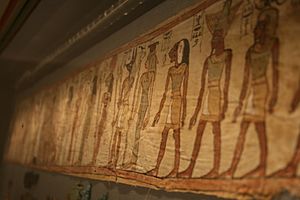Mummification facts for kids
Mummification is a special way to preserve a dead body. It keeps the skin and flesh from rotting away. This process can happen naturally, or people can do it on purpose.
Natural mummification happens when a body is in very cold places like a glacier, in acidic water like a bog, or in very dry conditions. The ancient Egyptians wrapped bodies in bandages to protect them from decay.
Mummies of both humans and animals have been found all over the world. Many animal mummies, especially cats, have been discovered in Egypt. The Egyptians carefully removed most organs, but they left the heart. This was because the heart was important for a ceremony called the "weighing of the heart" after death. The other organs were placed in special containers called canopic jars and buried with the mummy.
What is Intentional Mummification?
Intentional mummification was a common practice in ancient Egypt. It was especially used for burying Egyptian pharaohs, who were their kings. Many people believe that Osiris, a god, was the first mummy in Egypt.
The mummification process took about 70 days to finish. First, a sharp tool was pushed up the nose into the brain. The brain was broken into small pieces and removed through the nose. Then, the nose was filled with sawdust.
Next, a cut was made in the body to remove all the organs except for the heart. These organs were stored in special jars that had the heads of gods on their lids. The cut was then filled with linen and spices. The body was then covered in a special salt called natron to dry it out for about 40 days.
After drying, the body was wrapped carefully in many layers of linen bandages. Priests would perform important rituals while the body was being prepared. Once the mummification was complete, a mask was placed over the mummy's head. This was so the person could be recognized in the afterlife.
Mummies in Ancient Egypt
Anyone in ancient Egypt who could afford it was allowed to be mummified. Egyptians believed in life after death. They thought that death was just a journey from one life to another. They preserved their bodies so they could live a new life. They also believed they would need their belongings, so families would place items in their graves.
Egyptians paid a lot of money for this long and detailed process. It took 70 days to prepare a body. Canopic jars were very important for holding the internal organs. Preserving the human body was a key part of their religion.
Anubis was an important god of mummification. He had a human body and the head of a jackal. His job was to prepare the dead body to be welcomed by Osiris, the god of the dead. Osiris would then allow the souls to enter the underworld.
Images for kids
-
Jeremy Bentham wanted his body to be preserved after he died.
See also
 In Spanish: Momia para niños
In Spanish: Momia para niños








